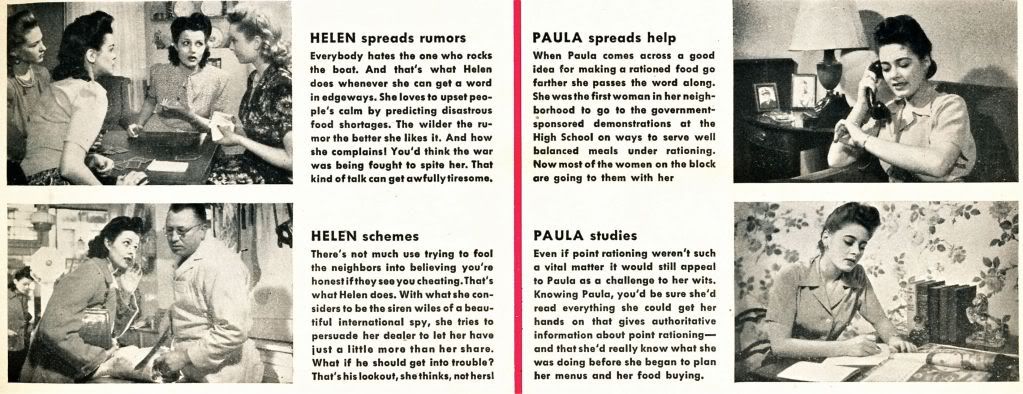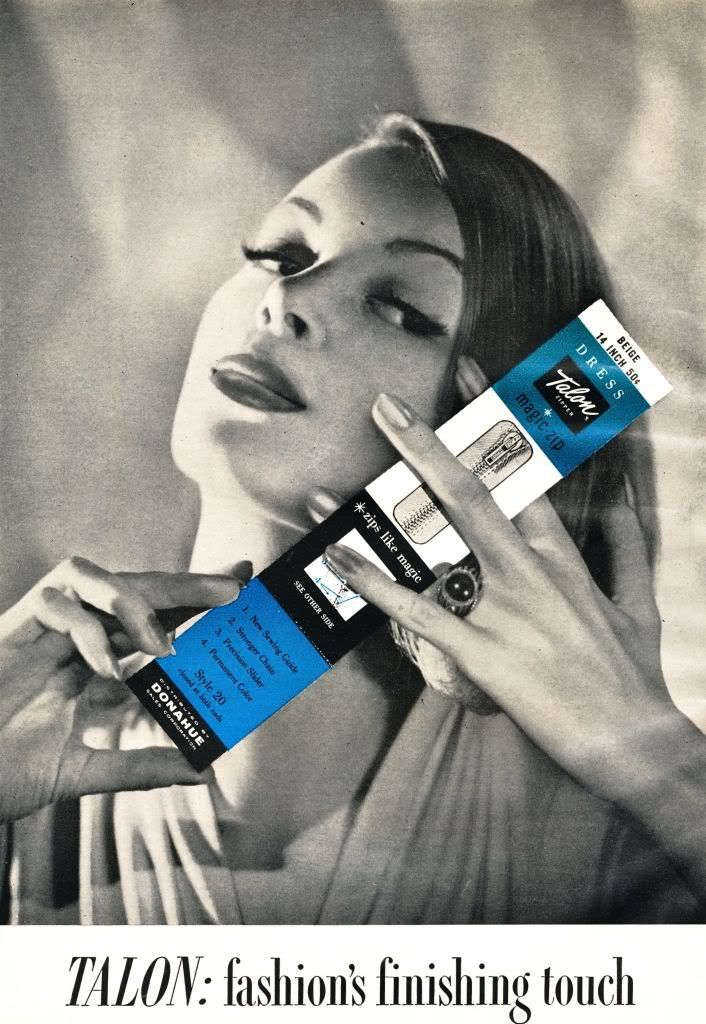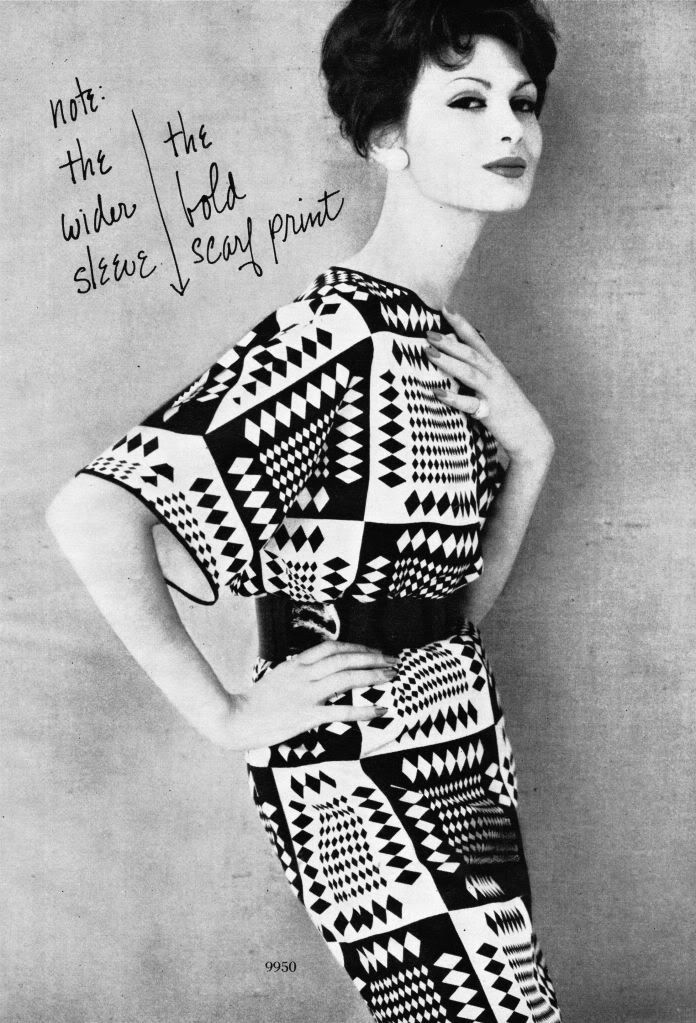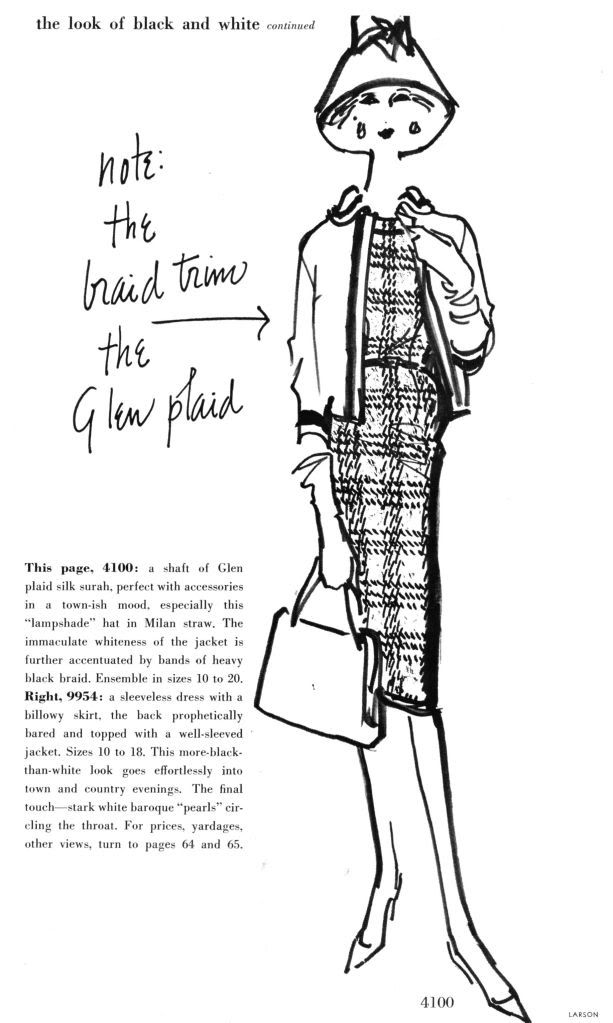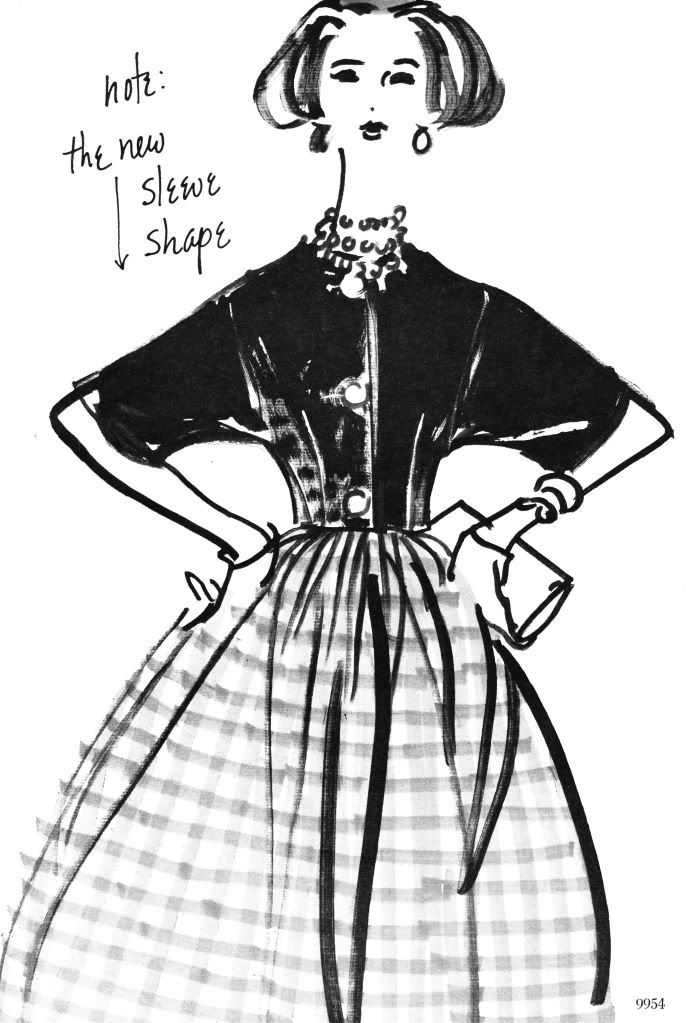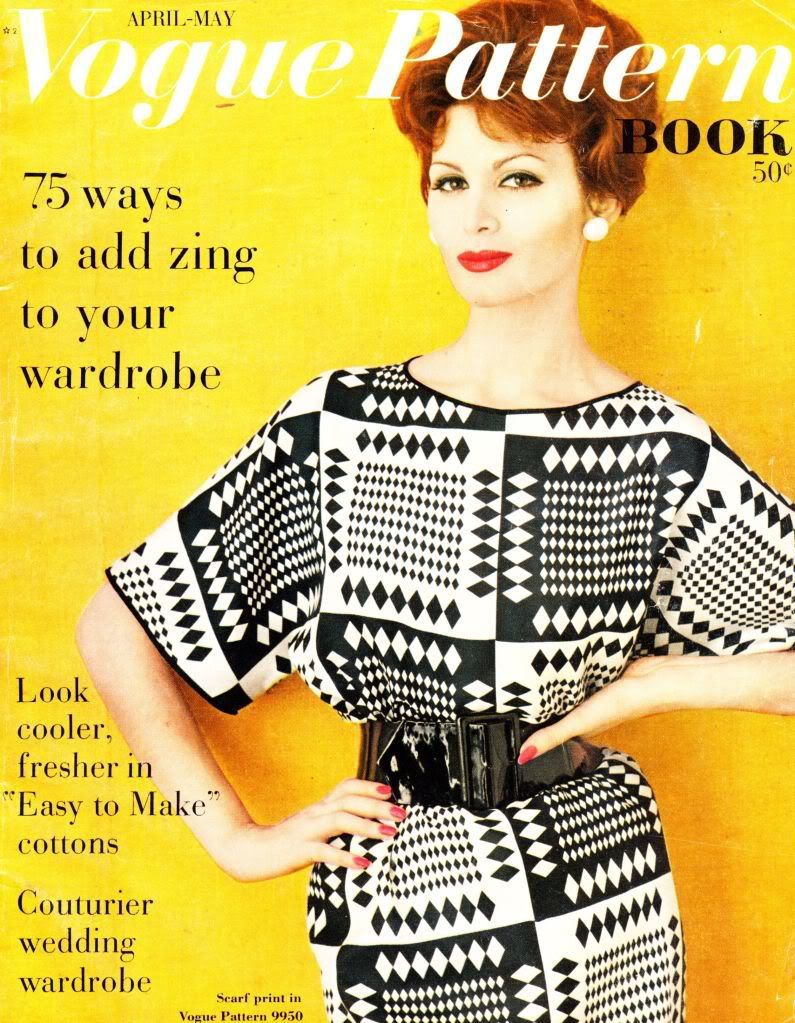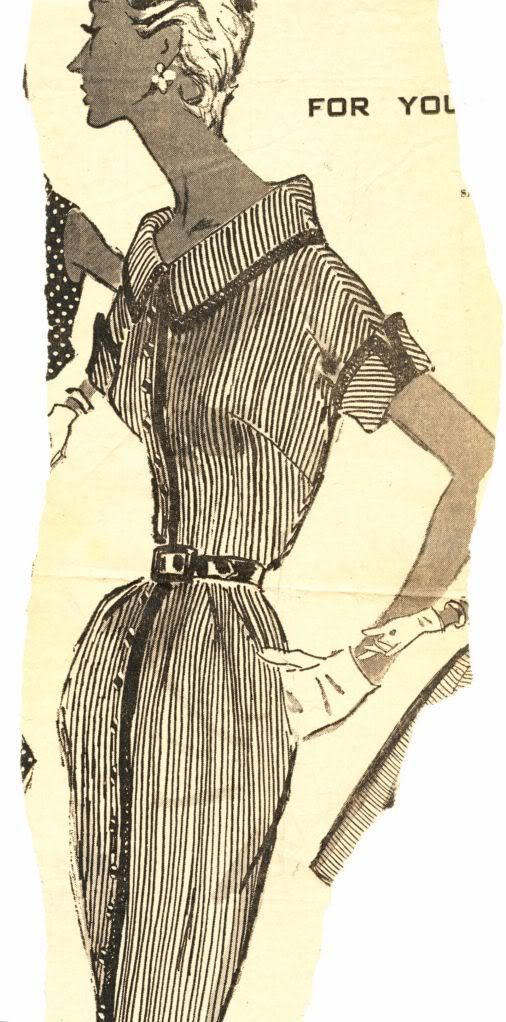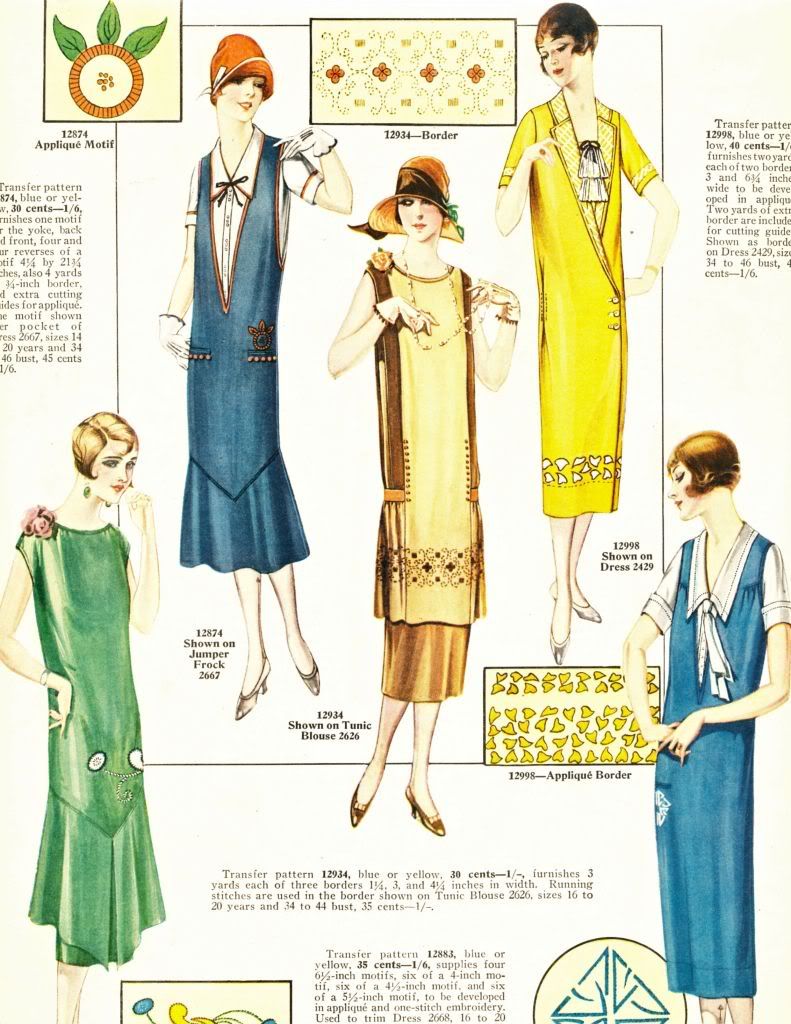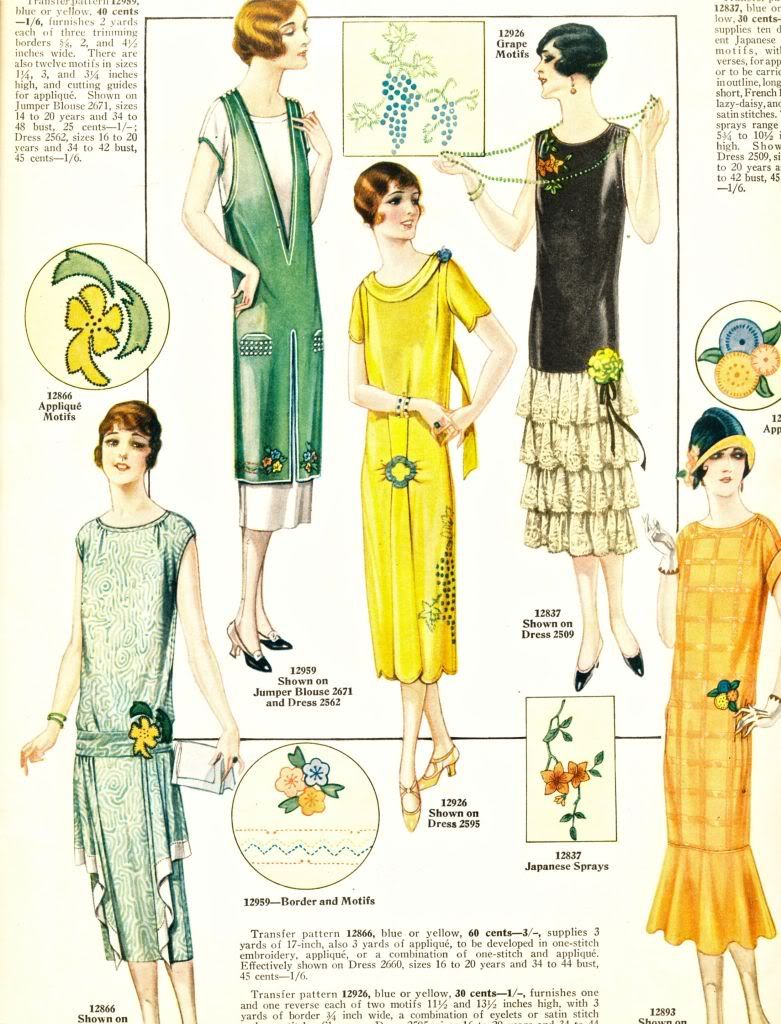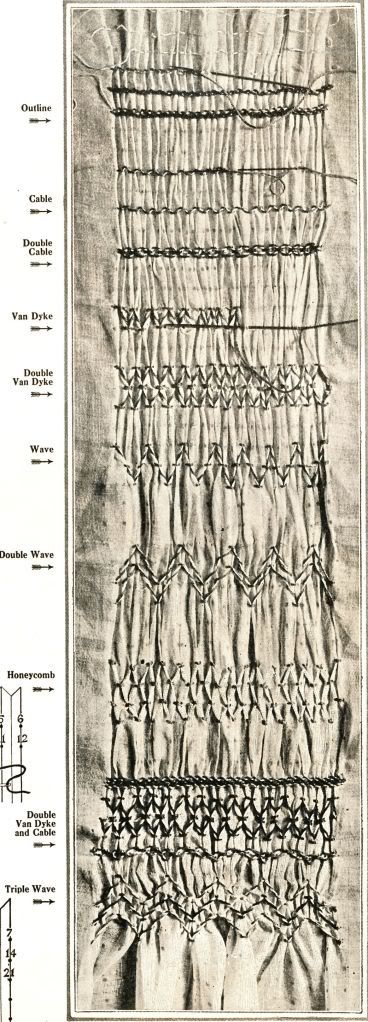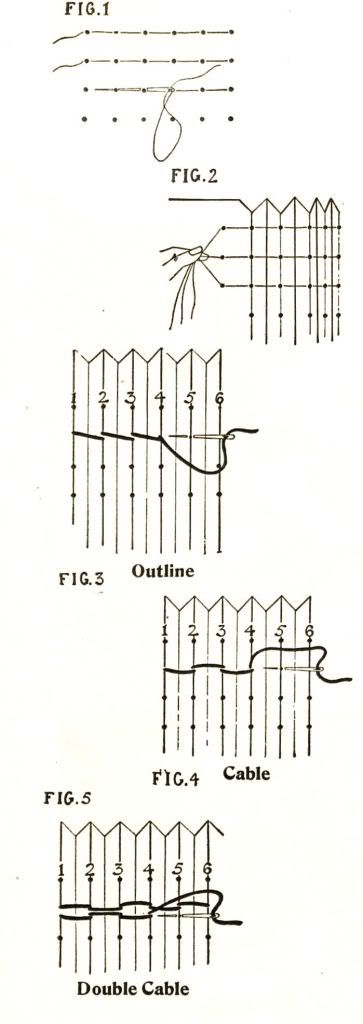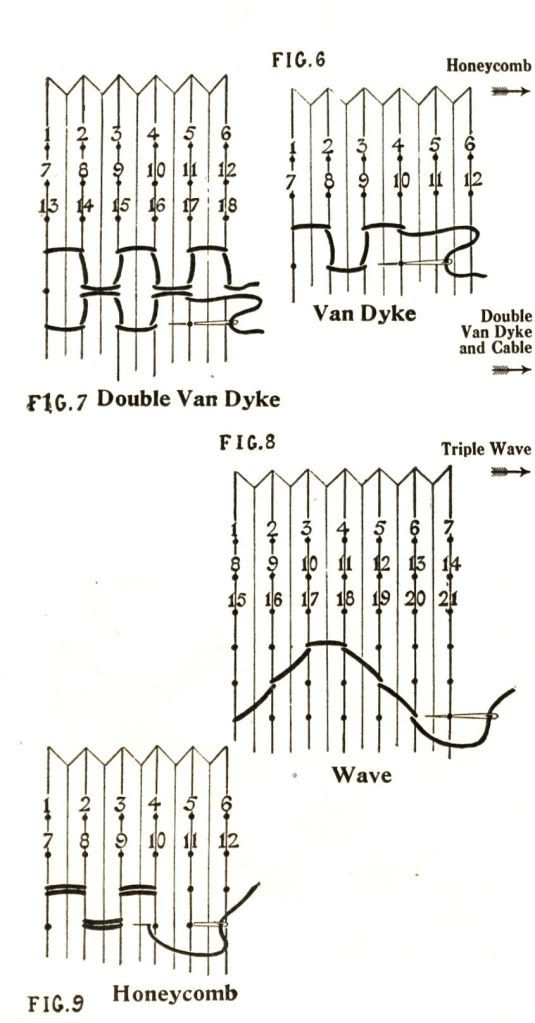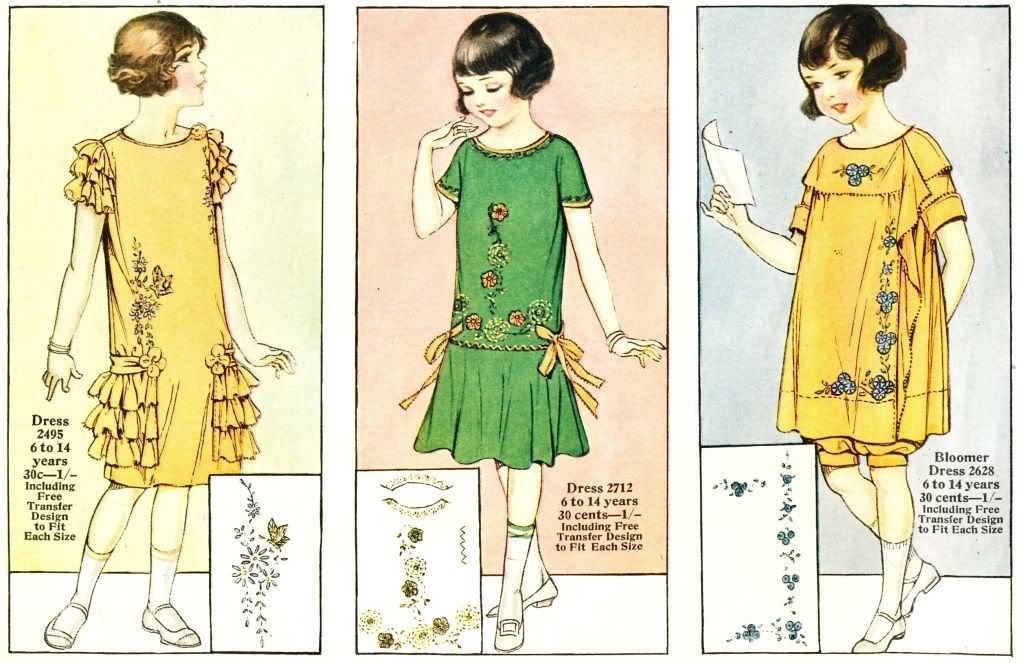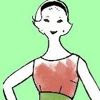Yep, that Helen is headed for trouble. After all "people who are busy winning a war don't find dimwits amusing!"
Thursday, May 31, 2012
Which Woman's On Her Way To Being Hated?
Tuesday, May 29, 2012
Wardrobe for a Summer Bride - 1960
We have 'a prerequisite to a wedding trip, a travel suit', 'a champagne evening dress', then 'an ensemble that will work for practically every daytime occasion', and 'a softly draped dress, perfect for little dinners'. But the best is of course, "a toast in lace for a bride who wants the most beautiful wedding gown".


Vogue 208: the bridal dress, a lavish sweep of delicate lace, sashed and partially enveloped in an overskirt of white satin. Petticoat, short dress, included. Sizes 10 to 16.
Vogue 204: the strapless dress with an artfully molded bodice, swirling into a full skirt with graceful mobility for dancing, (can also be floor-length). This, and the brief jacket, designed by John Cavanagh. Sizes 10 to 18.
Vogue 200: the ensemble, an original by Michael of London. The slim dress with easy width through the bodice is topped by a belted, hip-length jacket. Sizes 10 to 18.
Vogue 206: the draped dress., interpreted here in fluid floral crepe. Original design by Rodriguez of Spain. Sizes 10 to 18.
Vogue 207: the going-away suit ... uncluttered lines in an almost classic travel suit, plus its own blouse. Original by Giovanelli of Italy; sizes 10 to 18.
Saturday, May 26, 2012
Wednesday, May 23, 2012
Choose the Bold Look of Black and White - 1960
These illustrations are done by 'Larson', probably Esther Larson. If anybody knows more about her please share.
Now let's see what the extroverts were wearing in 1960!
Here, and on the next five pages, a decisive change of pace for now-into-summer dressing . . . scarf-print, domino dots, abstract florals, staccato plaids . . . more dashing than ever in the stark contrast of black and white!
Left, 9970: excitement that starts with black and white, builds momentum by the use of black-bordered scarves-by-the-yard. This is further accented by the voluminous belled skirt of the two-piece dress and the wide sleeves that curve outward. "Easy to Make," 10 to 16.
Opposite, 9950: more of the same sleeve shape, this time funneling into a slim skirt. This is a prime example of the positive approach to fashion . . . so pretty, we've shown it on the cover, too! Sizes 10 to 18. Maxwell's silk surah scarf-fabric harlequin-printed squares. For an extra accent, black silk binding was added around the neck, sleeves. Wide belt, Midtown; Marvella "pearls.
This page, 4100: a shaft of Glen plaid silk surah, perfect with accessories in a town-ish mood,especially this "lampshade" hat in Milan straw. The immaculate whiteness of the jacket is further accentuated by bands of heavy black braid. Ensemble in sizes 10 to 20.
Right, 9954: a sleeveless dress with a billowy skirt, the back prophetically bared and topped with a well-sleeved jacket. Sizes 10 to 18. This more-black-than-white look goes effortlessly into town and country evenings. The final touch-stark white baroque "pearls" circlida the throat.
Opposite, 9947: probably the most dashingly feminine way to look at home since the age of the tea gown, these conversation-piece culotte-pajamas in soft, fluid silk, imprinted with newsy freeform circles. Here, sashed in ebony silk, jacketed in charcoal. In sizes 10 to 18.
Right,
9895: hothouse flowers that could only grow on silk, printed in crisp black-on-white and
blooming here on floor-length at-home separates. The collar, a graceful sweep of more flowers,
tucked, face-flattering. The cummerbund wraps a waistline to slender stem width. Sizes 10 to
16.
Monday, May 21, 2012
Joan Holloway Look-a-Like!
We don't have the models name, but the photographer is Carmine Schiavone, who was a very famous photographer of many models. I'm quite sure Joan Holloway would have been a fan!
Sunday, May 20, 2012
Are You A Person...? Appearance Checklist - 1959
GROOMING CHECK LIST
ARE YOU A PERSON-
Whose posture is the best it can be? ------------
Who bathes daily? ------------
Who uses a deodorant or anti-perspirant always? ------------
Who keeps her underarms and legs free from hair? --------
Who washes her face without fail before going to bed? ------------
Who relies on milk, fresh fruits and vegetables as beauty aids? -----------
Who keeps her figure slim and trim with proper foods, regular exercise? ------------
Who keeps her hair radiantly clean and well cared for? ------------
Who plans ahead for permanents and gets them when she needs them? -----------
Who is particular about clean combs, brush, towels and powder puffs? ------------
Who puts fresh make-up on a clean face, never slathering new make-up over old? ------------
Whose bands and nails are clean and well cared for? ----------
Who starts each day with clean hose and under-wear? ------------
Who sews instead of pins herself together?------------
Who wears the right style slip which doesn't show beneath nor through her dress? ------------
Who wears polished, well-fitted shoes with straight heels? ------------
Whose clothes are "ready to go" on a moment's notice? ------------
Who brushes, airs and presses her clothes between wearings? -----------
Who sets a good grooming example for her family? ------------
Who works out a good grooming routine-daily and weekly? ------------
Saturday, May 19, 2012
Look Your Best... a well-groomed woman - 1959
"Today's woman with her busy life, has not lost the formula for personal attractiveness..." she just needs to "...climb right back up on the pedestal of feminine charm and beauty"
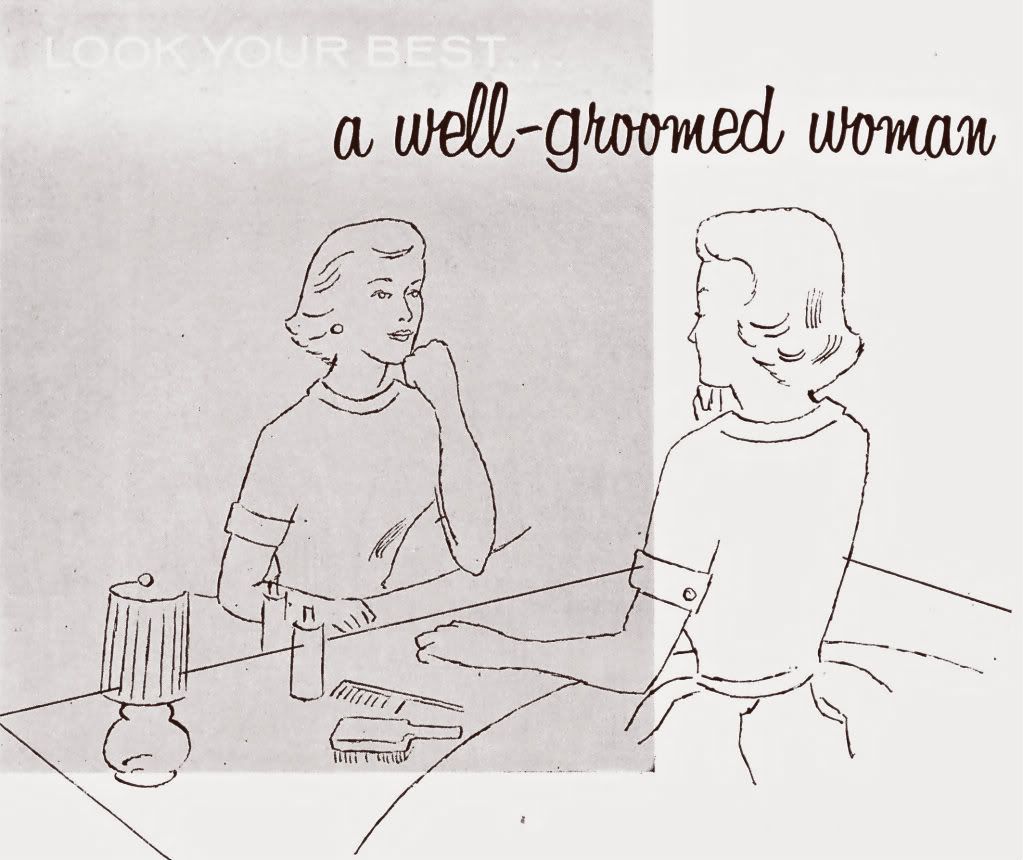
"Personal attractiveness...self confidence...poise...these and many other qualities we admire are the dream and desire of every woman. Else why would we all be so interested in our own appearance?
This "Touch of Ego"...this desire to be our most attractive selves for family and friends...is, in a sense a sincere compliment to our own personal worth...a refection of honest self-respect.
Today's woman with her busy life, has not lost the formula for personal attractiveness, though she may unintentionally have mislaid it. Hers not to bemoan "I can't do a thing about my looks". Hers not to complain, "I haven't a minute to myself". Hers to climb right back up on the pedestal of feminine charm and beauty and to expect admiring glances from Dad, Sis and the rest of the family. Also they may follow her good grooming example! ".
Friday, May 18, 2012
Inspiration In a Pattern Envelope - 1954 Seattle Times
Thursday, May 17, 2012
Complete Costumes in Exciting Colors - 1961 Seattle Times
This was "a Dorothy Neighbors Fashion Report" from January, 18, 1961. I grew up with the name Dorothy Neighbors in my local paper, the Seattle Times. It covered everything woman needed to know about fashion and food in Seattle. It was the nom de plume of Marilyn Kirkby, who wrote for the paper for 35 years.
We also have the illustrators name, Gerry Abbott,"For more than 20 years, Mrs. Abbot created the weekly feature "Seen in a Seattle Store" in the Seattle Times."
"The dress plus jacket costume by Maurice Rentner is in two textures of silk. The yoked, short-sleeve top is a cane-weave check.
"Three piece-suit-suit costume was designed by Carmel in light gold wool. The jacket lining matches the tie silk print blouse."
There is a wonderful article about Gorge Carmel at the Couture Allure blog.
Wednesday, May 16, 2012
Embroidered 1920's Dresses from Pictorial Review Embroidery Magazine
These go from dresses you might wear at home to lovely gowns for your fanciest night out!
Monday, May 14, 2012
A Family of Fobs
"These fascinating fobs may be embroidered on the pocket of the blouse or suit, or even on the collar of one's coat. The faces, hair, and neck treatment may either be embroidered on the fabric, and the ribbon left hanging below, or they may be made separately. The faces, neck, and shoulders be made of kid or a tightly woven silk such as radium, taffeta, or satin. The faces can be transferred to the fabric by tracing over the lines with carbon paper between this page and the cloth. The lines of the faces may be embroidered or inked in, the cheek tinted with water-color, and the hair made with silk or wool of a suitable shade. Where ruffs are shown, these may be added of ribbon or lace. The ornamentation on the front of the figures may be embroidered on the ribbon, or the ribbon may be trimmed with the additional contrasting ribbon for vestees, or with buttons as indicated. The bottom of the ribbon may be gathered into a bead or ornament, or tassels may be added.
Bookmarks
These sketches can be used as bookmark suggestions as well. The heads, necks, and shoulders may be cut out of bristol board, inked and colored, and a narrower section of the bristol board cut and placed between the two pieces of ribbon. You can cut two tiny points for the feet and leave them to protrude from between the two pieces of ribbon. You can get some charming color effects if two different widths of ribbon and two different colors are used. These ribbons can be tacked together or cemented together with adhesive. A bow or ruff of ribbon at the neck will cover the bristol board and the raw edges of ribbon at the neckline."
Lamp - Pulls Pincushions Embroidery Designs
These designs can also be used as a finishing touch to the lamp-pull, instead of the metal chain, or as pincushions that are hung on the wall or on the mirror frame, or as embroidery designs on pockets and bags. If used as pincushions, the under piece of ribbon must be well padded with lamb's wool or felt. If used for embroidery designs on pocket and bags, the faces should be embroidered right on the pocket or bag, and the ribbon left to hang free. The ribbon can be lengthened or shortened, and can be of a color to harmonize with the background. These heads can also be used without the ribbons as hat ornaments and trimmings for pincushions, powder puffs, and nursery accessories."
Saturday, May 12, 2012
Pictorial Review Patterns make you look slender and youthful.
Wednesday, May 9, 2012
The Simpler Stitches of Smocking
In the early days when a peasant's blouse was not a fitted garment and there were sections that required gathering, in order to make them fit, smocking as a means of gathering the excess fabric came into being, and many were the variations that were introduced. Many of the simpler stitches are illustrated here.
The best aid in smocking is the row upon row of carefully and evenly placed dots, obtained most easily by using a stamping pattern. Usually two and a half times the width of the material (when finished) is required before stamping. You can he assured of more even and beautiful smocking if the gathering is done before the smocking is begun, and the width desired when finished determined and regulated by the gathering threads.
Fig. 1 shows the method of gathering the dots under the needle, and Fig. 2 shows how the material when gathered makes the plaits along the row of dots, which enables you to quickly take up the three or four threads of the fabric. Compress your materials into plaits so that the width of the plaited material is the width you wish for the finished smocking.
Outline Stitch (Illustration No. 3)
The outline stitch is worked on one line of horizontal dots. Begin at the left. Bring the needle up between dots 1 and 2. Pick up dot No. 1, keeping the thread below the needle. Pick tip dot No. 2 and draw slightly together. Continue by taking up dot No. 3, drawing together, then take dot No. 4 and continue, always keeping the thread below the needle.
Cable Stitch (Illustration No. 4)
The cable stitch is worked in the same manner as the outline stitch except that the thread in the first stitch is held under the needle and in the second stitch the thread is above the needle. The third is under the needle and the fourth above, continuing in alternating stitches.
Double Cable Stitch (Illustration No. 5)
The double cable stitch can be worked on one row of dots, keeping the second row of stitches close to the first row, using the same row of dots. If the top or first row is begun with a stitch with the thread held under the needle, the second row of stitches is begun with the thread held over the needle, alternating to the end.
Van Dyke Stitch (Illustration No. 6)
Starting at the left, bring needle up to the right of dot No. 1, take a stitch with the thread above the needle, through dot or plait No. 1. With the thread above the needle, take stitch through dot No. 2 from right to left. With the thread still above the needle, take stitch through dot No. 9. With the thread below the needle, take stitch through dot No. 10. With the thread below the needle, take stitch through dot No. 3. With the thread above the needle, take stitch through dot No. 4. Repeat until end.
Double Van Dyke (Illustration No. 7)
The first row is made the same as the single Van Dyke. The second row begins at dot No. 13, taking a stitch with the thread below the needle. With the thread still below the needle, it goes to dot No. 14. With the thread below the needle, to No. 8. With the thread above the needle, to No. 9, keeping the stitch under the previous row. With the thread above the needle, to No. 15 . With the thread below the needle, to No. 16, and with the thread below the needle, to No. 10, and with the thread above the needle, to No. 11.
Wave Stitch (Illustration No. 8)
Beginning at the left, bring the needle tip to the right of dot No. 15. Take a stitch through dot No. 13 with the thread under the needle. With the thread under the needle, take a stitch through dot No. 9. With the thread under the needle, take a stitch through dot No. 3. With the thread over the needle, take a stitch through dot No. 4. With the thread over the needle, take a stitch through dot No. 12, and with the thread over the needle, to dot No. 20. With the thread under the needle, continue to dot 21. If any of the dots are visible after smocking, remove with gasoline.
Honeycomb Stitch (Illustration No. 9)
Bring thread up through dot No. 1. Stitch No. 1 and 2 together with the thread over the needle. Draw needle through dot No. 2 again, and out through No. 8. Draw 8 and 9 together with thread tinder the needle. Bring through dot No. 9 up to 3, and stitch 3 and 4 together with the thread above the needle. Repeat.
Monday, May 7, 2012
Pictorial Review Magazine - Childs Frocks and Romper
Sunday, May 6, 2012
Modele Parisien - Last Minute Sketches from Paris
They were considered "a 'chic' collection specially selected by our personal representative in Paris through an exclusive arrangement with the greatest couturiers of the Champs Elysees, Rue de la Paix, and Palace Vendome. To meet the requirements of those who demand the most advanced creations of the Paris world of fashion..."
Saturday, May 5, 2012
Pictorial Review Embroidery Magazine
This is undated, but it was issued quarterly and this is number 31. If any body has an idea about a date please share, but this is clearly from the twenties. This are the flapper gals with the bobbed hair. The cover shows two young ladies in "charming frocks, suitable for graduation".
I have a lot to show you from this gem, but you get to save the cover price of 25¢ (30¢ By Mail).
Friday, May 4, 2012
"To women who make or would like to make their own clothes..."
"They almost talk to you!"



THE PICTORIAL REVIEW COMPANY
PUBLISHERS SEVENTH AVENUE AND THIRTY-NINTH STREET NEW YORK
Dear Madam:
Now, for the first time in history, you can get
• perfect PRINTED pattern -- a pattern you can use without
• moment's fear of making a mistake -- without a possible chance of cutting your material wrong.
The new simplified, printed. Pictorial Review Pattern almost talks to you as along. It tells you, right on pattern itself, how to cut your material without waste -- how to lengthen or shorten each piece to your individual lines -- how to match the pieces and put them together easily and accurately.
There are no superfluous margins on the Pictorial Review Pattern to confuse you, or trim off or fold over. Your material is always in sight while you are cutting it along the scientifically accurate edge of the pattern. You don't risk your material by having to cut through paper.
No other pattern in the world can offer you the advantages now found in the new Pictorial Review Printed Pattern. Not only in mechanical perfection -- but in chic and style. Many of these new patterns are based on original Paris models. Our representatives abroad cable us the newest style features~ which we translate at once into patterns for the women of America.
To illustrate our faith in the new Pictorial Review Printed Patterns we make,you this unequivocal guarantee: Should a dress at any time be spoiled through any defect in our pattern, every cent you may have spent for materials will be refunded.
-We want you to try these new Pictorial Review Printed Patterns -- to prove for yourself that there is just as much difference between them and any other pattern as between a gown made by a smart modiste and one made by a poor dressmaker. Most leading stores have them.
Improvements in Clothing - 1924 Primer of Hygiene
And don't forget to harden your knees!

